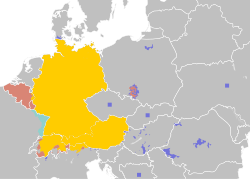German/Level I/Introduction
I.0: Introduction


Welcome to Level I German!
Level I is aimed at junior high and high school students. However, it can also be used by others just beginning to learn to speak or read German.
The goal of Level I German is to introduce the basics of the German language without overwhelming students. Therefore, the vocabulary is formatted for translating from English (which the students know) into German.
Although Level II is aimed at students and people who are a bit proficient after Level I, still, English translation will be used, so as to ease the learning. It helps because, at times while learning a new language, even with basic understanding, the words are above normal understanding level, and thus require a "sub" assistance.
German and English
[edit | edit source]German and English are quite close to each other, and are called language sisters or, more formally, cognate languages. Both belong to the Germanic branch of the Indo-European language family. Here are some major similarities:
- Both languages use the Latin alphabet.
- Normally, sentences follow Subject-Verb-Object order.
- Questions have Verb-Subject-Object order or Adverb-Verb-Subject-Object order.
- There are contractions (e.g., isn't) in both German and English.
- Many words share the same roots, such as word and Wort, or house and Haus.
- Many words are spelled almost the same way in English and German; for example, Text, Zoo, Handball, Motor, Bus, Park, Position, or Garage.
- Kindergarten (early school grade) is an English word borrowed directly from German, with a slight change of meaning from its original sense of daycare or nursery school.
As you can see, German is quite similar to English. There are, however, differences:
- German has more letters than and different pronunciations from English.
- In German the verb is sometimes the last word of a sentence.
- German has more verb forms than English.
- German is the only known written language where every noun is capitalized, whether or not it is a proper noun.
- The word ich (I) is only capitalized if it is the first word of the sentence.
- German has three different words for you.
- Adjectives have different endings based on the noun they are modifying in German.
- German does not have any Present Continuous tense, only Present tense.
However, German is still one of the easiest languages for English speakers to learn. The differences will be tackled over the course of the lessons.
How to Use this Level of the German Textbook
[edit | edit source]The lessons are meant to be taken in order. You should read and review the German dialogs as often as possible. Many of the dialogs come with audio recordings by native speakers. These recordings are invaluable to learn the German pronunciation. If there is a recording, you can do several kinds of exercises:
- Read the German dialog and translate it to English with the help of the vocabulary list.
- Listen to the dialog while you read it and try to understand as much as possible.
- Listen to the dialog without reading it, pause the playback after each sentence and translate it to English.
- Listen to the dialog without reading it, pause the playback after each sentence, and write it down in German.
- Listen to the dialog while reading it, stop after each sentence and repeat the pronunciation.
At the reviews, after every third lesson, go back to look at the previous lessons.
Layout of the Lessons
[edit | edit source]- Every lesson has a title at the top.
- The lesson will introduce several topics, more and more as the lessons progress.
- Topics are usually introduced by dialogs, which are accompanied by vocabulary lists.
- Each lesson features several problems and a test at the end. You should write down your answers (either electronically or on paper) before looking at the suggested answers. The act of writing down your answers will help you to learn the spelling.
- Level I uses a "more than enough" system for the problems. You don't have to do all of the problems if you think you know the material. However, the test may require knowing certain vocabulary, so you need to make sure you know it.
Levels of Completion
[edit | edit source]On the contents page, you will see filled-in boxes next to each lesson. The number of boxes corresponds to the completeness of the lesson as follows:
 - The lesson is started, with a lesson overview at least.
- The lesson is started, with a lesson overview at least. - At least half of the sections are complete.
- At least half of the sections are complete. - Most of the lesson is complete.
- Most of the lesson is complete. - The entire lesson is complete.
- The entire lesson is complete.
| (edit template) | (discussion) | |
|
Section I.A: | ||
|
Section I.B: | ||
|
Section I.C: | ||
|
Section I.D: | ||
|
Section I.E: | ||
